
Vol. 15 No. 1 |
Summer 2005 |

 Phyllis
Haskell MFA’70 found her calling in dance as a lettuce. An inauspicious
start, perhaps— but then, she was only 4. And you might be surprised
at what that little lettuce sprouted into.
Phyllis
Haskell MFA’70 found her calling in dance as a lettuce. An inauspicious
start, perhaps— but then, she was only 4. And you might be surprised
at what that little lettuce sprouted into.
Since 1997, Haskell has been dean of the U’s College of Fine Arts, and in 1999 she added associate vice president for the arts to her vita. In her role as dean, she has overseen the departments of art, ballet, modern dance, music, and theatre, and the Division of Film Studies; as associate vice president, she has also been responsible for the Utah Museum of Fine Arts, Pioneer Memorial Theatre, and Kingsbury Hall.
That seems like a lot to get one’s head around. But then Phyllis Haskell is no garden variety academic.
The petite and energetic Haskell has blossomed with each additional challenge and responsibility over her 30-some-year career, becoming a respected professional dancer, choreographer, teacher, and administrator. And when she retires in June, colleagues say hers will be a keenly felt absence.
“Phyllis has such an expansive understanding of all of the arts and has been such a great advocate and spokesperson,” says Ellen Bromberg, assistant professor of modern dance and assistant dean for research in the college. “She’s accomplished so much for the College of Fine Arts, and I feel that she’s brought a tremendous grace and strength to her leadership.”
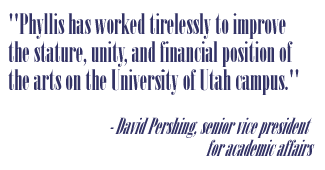 “Delightful,
visionary, passionate, and effective are all words that come to mind when
I think of Phyllis Haskell,” says David Pershing, senior vice president
for academic affairs. “Phyllis has worked tirelessly to improve
the stature, unity, and financial position of the arts on the University
of Utah campus.”
“Delightful,
visionary, passionate, and effective are all words that come to mind when
I think of Phyllis Haskell,” says David Pershing, senior vice president
for academic affairs. “Phyllis has worked tirelessly to improve
the stature, unity, and financial position of the arts on the University
of Utah campus.”
“I am always amazed at how a person with such slender feet fi ls such enormous shoes,” concurs Greg Geilmann, director of Kingsbury Hall. “With [so much] to oversee, the assignment would be daunting for most. For Phyllis, it is a matter of meticulous organization, like challenging choreography, always executed with grace and style. She has been a mentor, advisor and friend, and I will miss her.”
In recounting the germination of her now long career in the arts, Haskell
says—no evidence of tongue in cheek—“I didn’t
decide to be a dancer until I was 3. And I was very fortunate to have
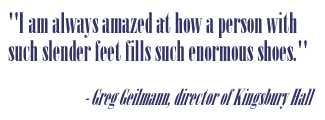 an
extraordinary ballet teacher [Madame Maria Kedrina] who had danced with
Pavlova and Nijinsky. She was from Russia and had escaped during the revolution
and come to Santa Barbara, Calif., where I lived just around the corner
from her studio. My mother took me there, and [Kedrina] said, ‘She’s
too young to start dancing—bring her back when she can skip.’
So my mother took me home and taught me how to skip, and I went back the
next day.”
an
extraordinary ballet teacher [Madame Maria Kedrina] who had danced with
Pavlova and Nijinsky. She was from Russia and had escaped during the revolution
and come to Santa Barbara, Calif., where I lived just around the corner
from her studio. My mother took me there, and [Kedrina] said, ‘She’s
too young to start dancing—bring her back when she can skip.’
So my mother took me home and taught me how to skip, and I went back the
next day.”
Haskell studied with Kedrina until she was 18, then headed off to college at the University of Arizona, a move that changed her focus, and her future. “They really didn’t have a ballet program, so I started studying modern dance—and that, really, was that.”
After graduating magna cum laude from UA, Haskell headed for New York City, where she studied with more master teachers and danced professionally. After five or six years, she decided to give dancing and teaching in San Francisco a try. But within a year, she returned to the U to pursue a master’s degree in dance—“to get my chops to teach at a university.”
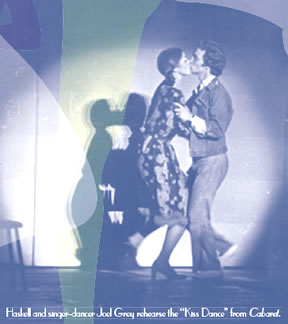 While
pursuing her master’s, Haskell began dancing with the budding Ririe-Woodbury
company. Then, degree in hand, she joined the faculty at Arizona State
University. “But after a year or so at Arizona,” Haskell says,
“Joan [Woodbury] and Shirley [Ririe] invited me to come back. I
had actually thought my performing career was over when I left San Francisco
for graduate school. But when they called me, I thought, ‘No, I’m
not finished with this.’ ”
While
pursuing her master’s, Haskell began dancing with the budding Ririe-Woodbury
company. Then, degree in hand, she joined the faculty at Arizona State
University. “But after a year or so at Arizona,” Haskell says,
“Joan [Woodbury] and Shirley [Ririe] invited me to come back. I
had actually thought my performing career was over when I left San Francisco
for graduate school. But when they called me, I thought, ‘No, I’m
not finished with this.’ ”
For several years, Haskell commuted back and forth between Tempe and Salt Lake City, teaching and performing. Then RW got a National Endowment for the Arts grant, giving the troupe the opportunity for full-time touring as a national, and international, company. Haskell leaped at the opportunity to join them full time, and danced with the company for three more years. “We traveled all over the world,” she recalls.
But again, Haskell found that she needed a new challenge and decided to go back to teaching at university level. “I sent in one application, to the University of Hawaii,” she recounts. “I had been there and just loved it.” Haskell joined UH as an assistant professor, and progressed quickly to associate professor, then, within four years, to director of dance.
While with UH, Haskell frequently performed, choreographed and taught in other locales including Taiwan and China, as well as back in San Francisco, Phoenix, and Salt Lake City. After several satisfying stints teaching master classes at the Hong Kong Academy for the Performing Arts, she took leave from UH to teach at the academy for a year, with an option to extend the contract for four more.
 But
soon another opportunity presented itself: She was invited to return to
the U to chair the modern dance department. With the U’s “incredible
reputation for dance,” she says, “it was really tempting to
come back to Salt Lake and contribute to the development of the program
here.”
But
soon another opportunity presented itself: She was invited to return to
the U to chair the modern dance department. With the U’s “incredible
reputation for dance,” she says, “it was really tempting to
come back to Salt Lake and contribute to the development of the program
here.”
Donna White BFA’76 MFA’79, current chair of modern dance, recalls one of Haskell’s earliest and most enduring marks on the department. Shortly after arriving as chair, Haskell devised a scheme to raise funds for department scholarships—red and white throw blankets, embroidered with an image of the buildings around Presidents Circle. “She had these designed and manufactured, and then she single-handedly organized selling them at foot- ball games and tailgate parties, and would go down to the malls at Christmastime… she was very creative in how she went about it.”
The fund eventually reached the $100,000 mark, and the department was asked to name it. White says Haskell was graciously resistant, but in the end the endowment came to bear her name. It now funds between one and four scholar- ships every year. The blankets are still sold as well (at U locations such as Kingsbury), and have become a popular U of U keepsake.
In 1997, Haskell took on management of the entire college. But within two years she concluded that it made no sense for the arts departments and agencies teaching at the U to be under the guidance of one vice president, while the performing and presentation arms reported to another. So in 1999, she added “Associate Vice President for the Arts” to her business card, a move she says helped the right hand know what the left hand was doing and facilitated them working together better as two limbs of one body.
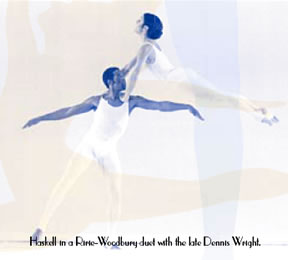 As
she looks to the future of the college, Haskell is particularly excited
about the ever-developing intersections between technology and the fine
arts that she has helped cultivate. “Right now, an audience at the
U can watch a dancer in a studio here perform a duet with a student in
Arizona, or Ohio,” she says, illustrating one example of interactive
arts collaboration (dance “telematics” projects, led at the
U by Bromberg) using Internet2, the high-performance online net- work
developed specifically for higher education. Haskell also cites the new
opportunities Internet2 offers for ArtsBridge projects, in which U students
go to schools to work with grades K-6 on short exercises in the arts,
such as composing music. “We can now take these teaching opportunities
to rural areas where they are lacking fine arts; as long as they can get
Internet2, we can interact with classes and teach.”
As
she looks to the future of the college, Haskell is particularly excited
about the ever-developing intersections between technology and the fine
arts that she has helped cultivate. “Right now, an audience at the
U can watch a dancer in a studio here perform a duet with a student in
Arizona, or Ohio,” she says, illustrating one example of interactive
arts collaboration (dance “telematics” projects, led at the
U by Bromberg) using Internet2, the high-performance online net- work
developed specifically for higher education. Haskell also cites the new
opportunities Internet2 offers for ArtsBridge projects, in which U students
go to schools to work with grades K-6 on short exercises in the arts,
such as composing music. “We can now take these teaching opportunities
to rural areas where they are lacking fine arts; as long as they can get
Internet2, we can interact with classes and teach.”
Bromberg, whose other technology-oriented pursuits in the College of Fine Arts include Web design, computer media, and digital editing courses, notes that one of the most exciting prospects for the future of fine arts and technology is using the former Museum of Fine Arts space as a new home for film studies, as well as a base for research into collaborative projects between architecture, fine arts, and engineering, such as installations and performances in interactive environments in which dancers’ motion triggers sound. “Right now we’re kind of doing it on the fl y, but all of these explorations would have a space where they could be more supported,” says Bromberg. “And Phyllis’s vision is for it to be a real laboratory for exploration. She’s been very active in trying to raise funds to further the renovation of the building to be a technologically sophisticated research lab.”
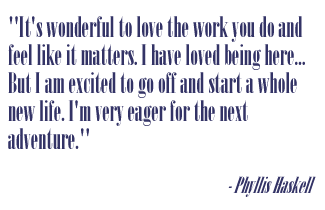
 As
for Haskell’s own explorations once she leaves the U, she says she
looks forward to traveling, river rafting, spending more time with her
husband, Doug Tims, and relaxing at their “home- stead” on
the Salmon River in Idaho. Haskell is an avid rafter and has floated rivers
around the world. Tims owns a rafting company, and the two met on a trip
on Idaho’s wild Selway River.
As
for Haskell’s own explorations once she leaves the U, she says she
looks forward to traveling, river rafting, spending more time with her
husband, Doug Tims, and relaxing at their “home- stead” on
the Salmon River in Idaho. Haskell is an avid rafter and has floated rivers
around the world. Tims owns a rafting company, and the two met on a trip
on Idaho’s wild Selway River.
Although Haskell has high praise for the many people who have made her time at the U “a delight,” she clearly looks forward to the growth her new path will bring.
“It’s wonderful to love the work you do and feel like it matters. I have loved being here…. But I am excited to go off and start a whole new life. I’m very eager for the next adventure.”
—Marcia C. Dibble is assistant editor of Continuum.